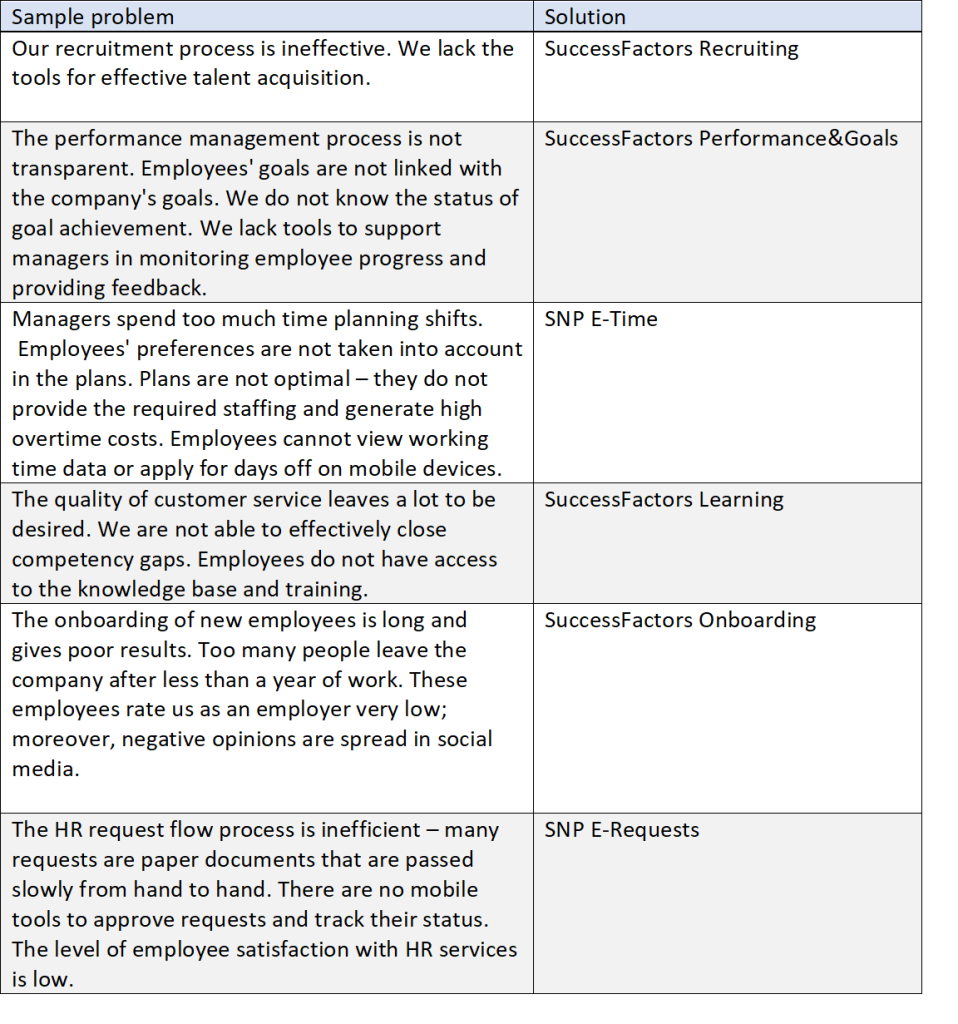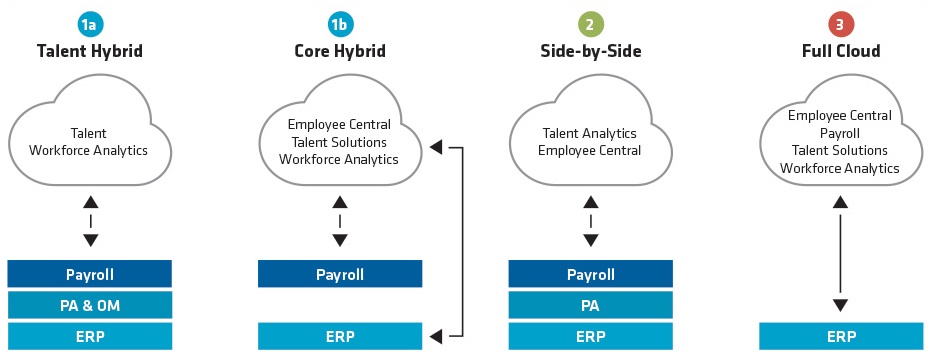There are many reasons…
At the beginning of every journey there is a business goal – we are not making a digital revolution to join the elite group of companies with “digitalized HR", but to achieve measurable benefits. Sometimes time is crucial – we need to quickly automate a specific process (e.g. working time planning) in order to maintain a competitive advantage. Another catalyst for changes may be the need to improve the quality of customer service (especially important for retail chains), the intention to reduce staff migration or the need to radically increase the effectiveness of recruitment. Sometimes a race to achieve a prominent market position requires us to quickly adopt best practices in a selected HR area, without interfering in other areas.
How to plan the optimal path to HR digitalization in order to reconcile these expectations with the capabilities of the organization at a given stage of development?
Towards the cloud
To help organizations transform, we offer a HR Cloud Fitting service. It will help the company answer a few key questions:
- What areas of HR in the organization can be improved with cloud solutions?
- What are the best practices in these areas and which of them can be adopted by the company?
- What is the optimal strategy for migrating selected processes to the cloud?
- What is the workload and recommended schedule of the migration?
The portfolio of SAP and SNP (now All for One Poland) cloud solutions is very extensive and, according to the “Start Anywhere, Go Everywhere” maxim, you can start the digitalization process from a selected area and gradually include subsequent components. An additional factor differentiating the migration path is the industry – requirements and challenges may differ depending on the service or product offered.
Different industries, different needs
Let’s take a look at a sample retail company. Here, the phrase “a satisfied employee means a satisfied customer” is as important as nowhere else.
The key challenges for retail companies are:
- achieving high efficiency in preparing staff for customer service (a great salesman means a returning customer) – the customer has so many options that we cannot afford low quality service;
- maximizing the income generated by the employee – this is particularly important in this industry, where the margin is very low;
- effective recruitment – the lack of a customer assistant, salesperson, cashier at the right time means a negative experience for the customer. In addition, the ability to predict the demand for talents, their rapid acquisition and training is a prerequisite for maintaining profitability and growth;
- effective management of staff working time – this challenge has several aspects:
- we want to relieve sales unit managers from tedious planning so that they can focus on sales;
- we want the staffing of work schedules to comply with the regulations and to take into account the availability of employees;
- we want employees to be able to deal with all matters relating to their working time anywhere and anytime, using a mobile device.
The most common key stakeholders in the retail industry are: HR Director, FI Director and Point of Sale Manager. The obstacles faced by them include:
- ineffective onboarding,
- inefficient talent management and lack of data-based decision support tools;
- ineffective training management – lack of automatic tools supporting the closing of competency gaps;
- lack of transparency in HR processes (including recruitment);
- problems related to sales optimization resulting from ineffective human resources planning;
- ineffective recruitment.
If we analyze the business factors taken into account by each of the stakeholders, it turns out that they are different. For the HR director, they will include: employee experience, mobility, transparency of succession plans, efficient handling of basic HR documents and processes, compliance with regulations. The finance director will focus on: maximizing income per employee, cost control, managing profitability and competitiveness. Finally, the point of sale manager is interested in the brand of the point of sale, satisfaction of customers and effective personnel management.
A similar analysis can be carried out for each industry. For example, for the consumer goods industry the key challenge will be effective management of turnover of low-skilled workers (e.g. controlled by deliveries and orders among others), or the optimization of the employee’s time to full productivity (every minute is important).
Taking into account the company’s position on the market (against competition), expectations and challenges for key stakeholders, as well as the current status of process computerization, we can propose an optimal way of HR digitalization.
Starting point
Selected HR applications may work effectively in the company (e.g. payroll) and may not require to be modified or replaced, and the main challenges may be related to talent management and recruitment. In another case, HR systems have not been developed for years and the business handling time is no longer acceptable. Therefore, the starting point of the path to the cloud may be different for each company. The advantage of SuccessFactors and SNP solutions is that they enable us to choose from this universe the component that we need at the moment and to add more with time. This is shown in the table in a simplified way.

Depending on the chosen strategy, we distinguish 3 basic models of launching Successfactors cloud solutions:
- Hybrid model (Talent Hybrid or Core Hybrid)
- Full cloud model (Full Cloud HCM)
- Mixed model (Side-by-Side)
Each of these models can have different implementation cases. The Talent Hybrid architecture will be ideal for an organization that uses the SAP ERP HCM solution effectively and wants to launch talent management in SuccessFactors. A typical example is a company that has implemented SAP HR PA and OM modules interoperating with Success Factors Performance & Goals.
While a full cloud model seems obvious (all components in the cloud), a mixed architecture may be suitable for dispersed organizations, in which individual companies/subsidiaries (perhaps immediately after the takeover) are at a different stage of digitalization and it seems rational to launch SF EmployeeCentral for them, while the parent company uses SAP ERP HCM. Talent management for the entire organization (regardless of the “hard HR” solution) is supported by Success Factors.

Models of launching cloud solutions
As part of the All for One HR Cloud Fitting service, consultants together with the customer will develop a recommended model in which an organization can migrate selected processes to the cloud. This model can be an intermediate stage before the complete transition to the cloud.
All for One HR Cloud Fitting: take the first step to the HR cloud
We offer companies the HR Cloud Fitting service, which allows them to select the optimal strategy for digitalization of selected HR areas. The service includes a package of activities – from the analysis of key HR processes of the customer in terms of opportunities for improvement through digitalization and migration to the cloud, through SuccessFactors module workshops with the indication of best practices, to a recommendation of the optimal strategy for migrating selected processes to the cloud together with an estimation of workload and a preliminary project schedule.
HR application management: a solution for the duration of migration
The implementation of a new, cloud-based HR platform in a large organization requires significant involvement of people responsible for maintaining the existing HR support solutions. During a project lasting many months, the existing HR system must function as before, with internal support provided. Therefore, the question arises as to what should be done to prevent the implementation of the new platform from disrupting the operation of the company’s key system, such as payroll or HR administration. The answer is the SAP HR application management service from SNP (now All for One Poland), provided for the duration of the migration project. As part of the service, a dedicated team of our service consultants can take over the responsibility for the maintenance of the HR System from the internal team on the Customer’s side, and thus the company’s own specialists can get involved in a priority project. The responsibility for maintenance is taken over after the transition phase, in which specialists from the customer’s team provide SNP consultants with the necessary information about the specific features of the HR system, and its key processes or functions that are critical for the maintenance. Once the project of implementing a new HR platform has been completed, the customer’s internal team takes over the role of internal support for the new solution, or alternatively, SNP begins to provide support for the new solution.
Michał Adamczewski, Support Services Deputy Director, All for One Poland

